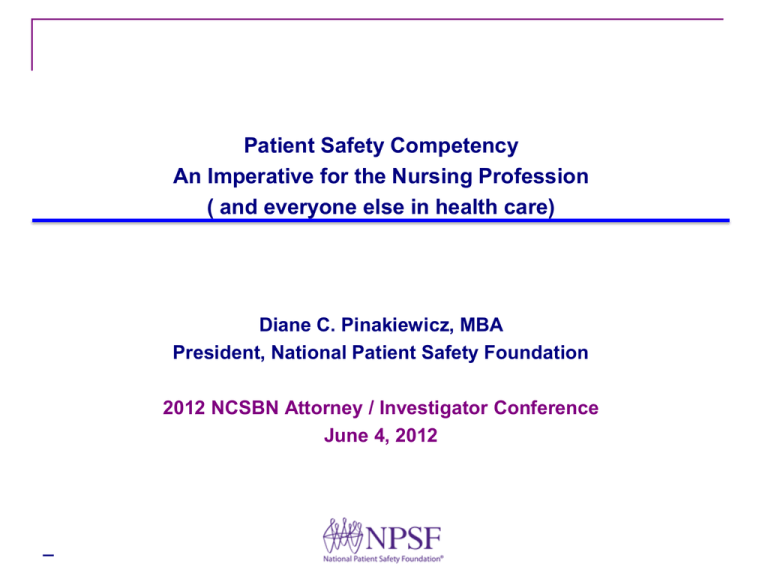NPSF Program Portfolio - National Council of State Boards of Nursing
advertisement

Patient Safety Competency An Imperative for the Nursing Profession ( and everyone else in health care) Diane C. Pinakiewicz, MBA President, National Patient Safety Foundation 2012 NCSBN Attorney / Investigator Conference June 4, 2012 _ NPSF Program Portfolio Annual Patient Safety Congress Patient Safety Awareness Week Patient Safety Moderated ListServ Patient and Family Programs Corporate Council Research Grants Program Information Resources Website/ Current Awareness Literature Alert/ FOCUS Newsletter Stand Up for Patient Safety Program Hospital-based Ambulatory/Physician Office Practice based Patient Safety Leadership Fellowship Program Educational Modules and Webinars Partnership for Clear Health Communications @ NPSF Lucian Leape Institute @ NPSF American Society for Professionals in Patient Safety NPSF Online Patient Safety Curriculum Certification Board for Professionals in Patient Safety MISSION STATEMENT The Lucian Leape Institute at the National Patient Safety Foundation is dedicated to providing thought leadership and strategic vision for the field of patient safety MEMBERS Lucian L. Leape, MD, Chair Adjunct Professor of Health Policy, Harvard School of Public Health Carolyn M. Clancy, MD Director, Agency for Healthcare Research and Quality Susan Edgman-Levitan, PA Executive Director, John Stoeckle Center for Primary Care Innovation Gary S. Kaplan, MD, FACMPE Chairman and CEO, Virginia Mason Medical Center Julianne M. Morath, RN, MS Chief Quality and Safety Officer, Vanderbilt University Medical Center Dennis S. O'Leary, MD President Emeritus, The Joint Commission Paul O’Neill Former Chairman & Chief Executive Officer Alcoa 72nd Secretary of the US Treasury Diane C. Pinakiewicz, MBA President, NPSF and President, Lucian Leape Institute Past Members James B. Conway, MAM, CHE Senior Vice President, Institute for Healthcare Improvement James A. Guest President, Consumers Union Donald Berwick Former President and CEO, Institute for Healthcare Improvement David Lawrence, MD Chairman & Chief Executive Officer (Retired) Kaiser Foundation Health Plan, Inc. and Kaiser Foundation Hospitals LLI Five Transforming Concepts Reforming Medical Education Care Integration Finding Joy and Meaning in Work Consumer Engagement Transparency The Health Professions Education Challenges Aligning curricula with the IOM core competencies Emphasis on the basics of patient safety and health care quality Creation of models for team training Development of new teaching and training modalities 7 Medical Education Design Failures Educational strategies Lack of emphasis on behavioral training Missed multi-disciplinary educational opportunities Modest use of case studies Insufficient use of simulation 8 Missing Foci in Medical Education Safety science Systems thinking and analysis Human factors knowledge Teaming concepts Communication skills 9 UNMET NEEDS Recommendations Setting the Right Organizational Context Strategies for Teaching Patient Safety Leveraging Change UNMET NEEDS Recommendations Setting the Right Organizational Context Recommendation 1 Medical school and teaching hospital leaders should place the highest priority on creating learning cultures that emphasize patient safety, model professionalism, enhance collaborative behavior, encourage transparency, and value the individual learner. Recommendation 2 Medical school deans and teaching hospital CEOs should launch a broad effort to emphasize and promote the development and display of interpersonal skills, leadership, teamwork, and collaboration among faculty and staff. UNMET NEEDS Recommendations Setting the Right Organizational Context Recommendation 3 As part of continuing education and ongoing performance improvement, medical school deans and teaching hospital CEOs should provide incentives and make available necessary resources to support the enhancement of faculty capabilities for teaching students how to diagnose patient safety problems, improve patient care processes, and deliver safe care. Recommendation 4 The selection process for admission to medical school should place greater emphasis on selecting for attributes that reflect the concepts of professionalism and an orientation to patient safety. UNMET NEEDS Recommendations Strategies for Teaching Patient Safety Recommendation 5 Medical schools should conceptualize and treat patient safety as a science that encompasses knowledge of error causation and mitigation, human factors concepts, safety improvement science, systems theory and analysis, system design and re-design, teaming, and error disclosure and apology. Recommendation 6 The medical school experience should emphasize the shaping of desired skills, attitudes and behaviors in medical students that include, but are not limited to, the Institute of Medicine and Accreditation Council for Graduate Medical Education (ACGME)/ American Board of Medical Specialties (ABMS) core competencies – such as professionalism, interpersonal skills and communication, provision of patient-centered care, and working in interdisciplinary teams. National Patient Safety Foundation 268 Summer Street, Sixth Floor | Boston, MA 02210 | w w w . n p s f . o r g UNMET NEEDS Recommendations Strategies for Teaching Patient Safety Recommendation 7 Medical schools, teaching hospitals, and residency training programs should ensure a coherent, continuing, and flexible educational experience that spans the four years of undergraduate medical education, residency and fellowship training, and life-long continuing education. National Patient Safety Foundation 268 Summer Street, Sixth Floor | Boston, MA 02210 | w w w . n p s f . o r g UNMET NEEDS Recommendations Leveraging Change Recommendation 8 The LCME should modify its accreditation standards to articulate expectations for the creation of learning cultures having the characteristics described in Recommendation 1above; to establish patient safety education – having the characteristics described herein – as a curricular requirement; and to define specific terminal competencies for graduating medical students. Recommendation 9 The ACGME should expand its Common Program Requirements to articulate expectations for the creation of learning cultures having the characteristics described in Recommendation 1: to emphasize the importance of patient-safety related behavioral traits in residency program faculty; and to set forth expected basic faculty patient safety competencies. National Patient Safety Foundation 268 Summer Street, Sixth Floor | Boston, MA 02210 | w w w . n p s f . o r g UNMET NEEDS Recommendations Leveraging Change Recommendation 10 The LCME and the ACGME should direct particular attention to the adequacy of the patient safety-related preparation of graduating medical students for entry into residency training. Recommendation 11 A survey of medical schools should be developed to evaluate school educational priorities for patient safety, the creation of school and teaching hospital cultures that support patient safety, and school effectiveness in shaping desired student skills, attitudes, and behaviors. Recommendation 12 Financial, academic, and other incentives should be utilized to leverage desired changes in medical schools and teaching hospitals that will improve medical education and make it more relevant to the real world of patient care. LLI Five Transforming Concepts Reforming Medical Education Care Integration Finding Joy and Meaning in Work Consumer Engagement Transparency American Society of Professionals in Patient Safety -- Membership Categories Professional Membership Patient Advocate Membership Student Membership Affiliate Membership Any individual who is actively involved in the patient safety field in a professional capacity or whose role has an impact on patient safety. Any individual who is actively working in the patient safety field representing the patient and family perspective. Any individual who is currently pursuing a degree in healthcare, whether clinical or administrative, and is interested in patient safety. Any individual who has a strong interest in learning about and supporting patient safety work, but is ineligible for Professional, Patient Advocate, or Student Membership. NPSF Online Patient Safety Curriculum Modules and Faculty Module 1: The Science of Patient Safety Robert M. Wachter, MD Module 2: Advancing Patient Safety through Systems Thinking & Design Doug Bonacum, MBA, BS, and Jeffrey B. Cooper, PhD Module 3: Identifying and Mitigating Patient Safety Risk Barbara J. Youngberg, BSN, MSW, JD Module 4: Establishing a Patient Safety Culture Gerald B. Hickson, MD, and Barbara M. Balik, EdD, MS, RN Module 5: Increasing Patient Safety Awareness and Practice among Clinicians and Staff Julianne Morath, RN, MS, and Pauline F. Robitaille, MSN, RN, CNOR Module 6: Strategies for Engaging Executive and Clinical Leaders Gary S. Kaplan, MD, FACMPE NPSF Online Patient Safety Curriculum Module 7: Principles and Strategies for Patient and Family Engagement Saul N. Weingart, MD, PhD Module 8: Methods for Measuring Performance and Clinical Outcomes Maulik S. Joshi, DrPH Module 9: The Role of Health Information Technology in Patient Safety Jane D. Englebright, PhD, RN, and Tejal K. Gandhi, MD, MPH Module 10: The National Landscape: Policy, Regulation and the Environment Gregg S. Meyer, MD, MSc 10 CME hours and 10-12 CEU hours (ACHE, nursing, pharmacy, risk management, and quality management) Establishes core standards for the field of patient safety, benchmarks requirements necessary for health care professionals, and sets an expected proficiency level Gives those working in patient safety a means to demonstrate their proficiency and skill in the discipline Provides a way for employers to validate a potential candidate’s patient safety knowledge and skill base, critical competencies for today’s health care environment Examination - Six Domains Culture Leadership Risk Identification and Analysis Data Management System Design Mitigating Risk Through Systems Thinking and Design and Human Factors Analysis External Influences on Patient Safety Eligible Candidates Patient safety practices as an integral component of current or future professional responsibilities and: Baccalaureate degree or higher plus 3 years of experience (includes time spent in clinical rotations and residency programs) in a health care setting or with a provider of services to the health care industry Associate degree or equivalent plus 5 years of experience (includes time spent in clinical rotations) in a health care setting or with a provider of services to the health care industry Advisory Committee Conclusion for Exam Specifications NPSF Multiple Choice Test Specifications Cognitive Level Recall Application Analysis Totals I. Mitigate Risk Through Systems Thinking and Design 0 13 9 22 I. Risk Identification and Analysis 0 11 11 22 I. Data Management System Design 0 6 9 15 I. Culture 1 14 5 20 I. Leadership 0 9 6 15 I. External Influences on Patient Safety 1 3 2 6 2 56 42 100 Content Area Totals CPPS Practice Exam/Exam Practice Exam: $65 Customer must complete all 50 questions within 60 days 50 item question bank is fixed Exam: Non-member: $325; ASPPS member: $275 100 item, 2 hour timed test Question bank rotates Candidates by Primary Credential Nursing credentials 67 (60%) Physician credentials 6 (5%) Pharmacist credentials 4 (4%) Other credentials 34 (31%) Other credentials include: CPHQ (11) CPHRM (7) PhD, MBA, MS, other (16) Pass Rates by Primary Credential Pass Rate Nursing: 78% Physician: 67% Pharmacist: 100% Other: CPHQ: 45% CPHRM: 57% PhD, MBA, MS, other: 13% 100 90 80 70 60 50 40 30 20 10 0 Pass Rate Summary of Candidates by Primary Job Description N = 111 Patient Safety Officers, Directors, Managers, Specialists (45) 41% Executives (includes Nursing and Physician Executives) (24) 22% Risk Managers/Quality Managers (12) 11% Nurses (8) 7% Mid-Level Managers (7) 6% Consultants (5) 5% Other (4) 4% Physicians (3) 3% Pharmacists (2) 2% Patient Advocates (1) 1% Pass Rates by Primary Job Description Patient Safety Officers, Directors, Managers and Specialists: 82% Executives: 79% Nurse Executives: 91% Physician Executives: 75% Non-clinical Executives: 67% Risk Managers/Quality Managers: 75% Mid-Level Managers: 71% Physicians: 33% Nurses: 50% Pharmacists: 100% Patient Advocates: 0% Consultants: 40% Other: 50% Pass Rates for Nurses by Job Category Overall 78% By Job Category 100 80 • PSO 83% 60 • Executive 91% 40 • Risk Manager 89% • Mid-Level Manager 60% 20 • Clinician 50% 0 Pass Fail Opportunities Curriculum for baseline training/ incorporation into nursing curricula Certification for expert training / recidivism programs Integration into licensing or maintenance of credentialing processes










